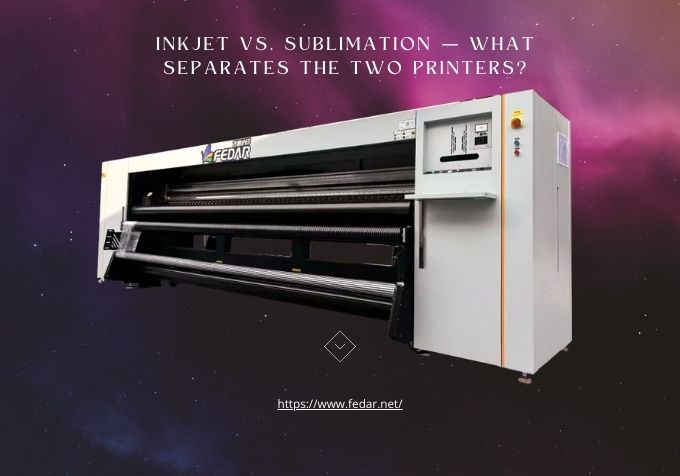21
Oct

Printers have become ubiquitous these days, whether we are talking about homes or offices. We are going to take a deeper look at how these two very commonly used printers work: inkjet and sublimation printers. In addition, we will talk about how the two differ precisely and what is more suitable for you. In this article, we will guide you in choosing the type of printer that suits your needs.
Ink droplets are sprayed onto the paper via liquid ink nozzles on the printhead. They are used for document and photo or image printing. Dye-based ink or pigment-based ink may be used for these printers.
Dye-based inks can be used to produce vibrant colors as they are more accurate, on the other hand, pigment-based inks make prints that tend to last longer and do not fade with time. These are a bit cheaper and easier for beginners to use.
Sublimation printers can print designs on almost anything, such as fabrics, ceramics, metals, and much more, surfaces an ordinary printer can't print on. The solid dye ink turns directly into a gas, bypassing the liquid stage (a process called sublimation). This printer uses heat to transfer the dyes onto the material, and a chemical bond is then created between them, resulting in one becoming part of the other.
Sublimation printing creates clear and vibrant designs that will not smudge, so sublimation has surged in demand among personalized products such as printed T-shirts, mugs, or other promotional materials.
In terms of prices, inkjet printers cost less compared to sublimation printers. The most basic models start at around $50. Sublimation printers, on the other hand, are generally more expensive with entry-level models costing from $300 to $400. That's not the end of it, either; production-grade inks and materials for these cost an order of magnitude more.
On the other hand, if enhanced print quality and much better longevity in customized products is one of your top priorities, then splurging into a good sublimation printer can justify every single penny. In the end, it really depends on what you want to print and how much (or little) the quality of print matters.
In general, you could say both inkjet and sublimation printers have equal levels of output quality, only that each innovates in its own way. The quality of the image in inkjet printers is amazing, especially when it comes to printing graphic images.
Sublimation prints, however, are incredibly durable. As we've discussed before, the ink is chemically attached to the fabric, creating a bonded print that DOES NOT fade, smudge, or peel. So this is where sublimation makes sense, and printed goods need a well-built product above all else.
Print materials are one of the most significant differences between inkjet and sublimation printers. Inkjet printers are best when printing text, graphics, and photos on paper.
Sublimation printers can even print on other materials. There are endless printing mediums for you to capitalize on, such as fabric, ceramics, coated surfaces, pottery, etc.
Sublimation printers are used for customizing items such as mugs, T-shirts, or phone cases by following creative and out of the box patterns on it. Conversely, an inkjet printer may be sufficient for you if your usage is limited to general daily tasks which involve document and photo printing.
They both create the same bright/vibrant color photo prints but operate differently. They use a combination of dyes or pigments from CMYK (cyan, magenta, yellow, and black) cartridges to achieve a detailed color-mixing process. Moreover, the possible combinations of colors produced by blending dyes are sufficient for accurate text or images to be covered on any printed paper.
Sublimation printers use CMYK dyes to give bright colors to items like polyester and ceramics. Sublimation prints chemically bond the dyes and their combinations to the material, not just layered on the surface like inkjet printers. Because of this, they look seamless, as though the print is part of the material. If you really need the colors to pop and not fade as well on a high-end customized product, then sublimation is worth considering.
Blocked printheads and dried ink cartridges are the major issues associated with inkjet printers. Therefore, some routine maintenance and care are essential so that these printers do not break down and run smoothly. Almost all the modern inkjet models which are in use nowadays have an in-built cleaning system but will still need time to time cleaning and checks so that they remain at their best.
Sublimation printers are relatively more reliable in terms of clogging of printheads, but they do need some care too, mainly if used very less. Sublimation ink dries out if the printer isn't used regularly, and this gives messed-up prints. The best performance of both the printers is just like any other machinery and gadgets when maintained and cleaned regularly. Proper storage and care ensure consistent performance of both the printers.
Which type of printer you choose depends on your printing requirements. While an inkjet printer is more economical and convenient for printing documents, photographs, or other paper products daily, a sublimation printer excels in printing uniquely diversified products on various materials like fabrics, ceramics, and coated surfaces.
The best choice for you depends on what you print and the budget you have. An inkjet printer is okay if you want something pretty versatile and not expensive. Still, if you need designs of quality and durability that should be collected and filtered based on your taste into different types of materials, a sublimation printer would be worthwhile to invest in. Good luck!
If there's anything we can do to further showcase machines' features, please let us know.
Email: sale@fedar.net
Whatsapp: http://wa.me/8615515715397
Our company has over 30 models of printers with independent intellectual property rights and patents. Marketed under the esteemed brands of Skycolor, Stormjet, and Fedar brands, these printers cover a wide range, including digital textile printers, UV printers, eco-solvent printers and more. Known for their exceptional quality and performance.
